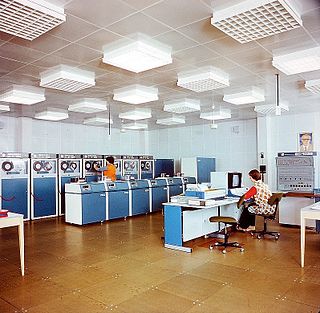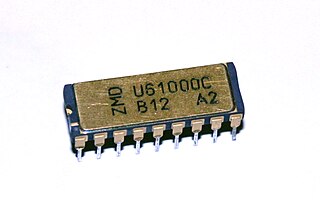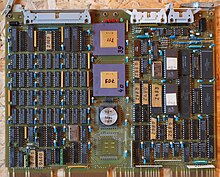
The PDP-11 is a series of 16-bit minicomputers sold by Digital Equipment Corporation (DEC) from 1970 into the late 1990s, one of a set of products in the Programmed Data Processor (PDP) series. In total, around 600,000 PDP-11s of all models were sold, making it one of DEC's most successful product lines. The PDP-11 is considered by some experts to be the most popular minicomputer.

VAX is a series of computers featuring a 32-bit instruction set architecture (ISA) and virtual memory that was developed and sold by Digital Equipment Corporation (DEC) in the late 20th century. The VAX-11/780, introduced October 25, 1977, was the first of a range of popular and influential computers implementing the VAX ISA. The VAX family was a huge success for DEC – over 100 models were introduced over the lifetime of the design, with the last members arriving in the early 1990s. The VAX was succeeded by the DEC Alpha, which included several features from VAX machines to make porting from the VAX easier.

VEB Kombinat Robotron was the largest East German electronics manufacturer. It was headquartered in Dresden and employed 68,000 people in 1989. Its products included personal computers, SM EVM minicomputers, the ESER mainframe computers, various computer peripherals as well as home computers, radios, television sets and other items including cookie press Kleingebäckpresse Typ 102.

ESER is an abbreviation for Einheitliches System Elektronischer Rechenmaschinen, a term used in the GDR for ES EVM computers produced according to a treaty between the members of Comecon signed on December 23, 1968 covering the development of a standardized computing system.

The history of computing hardware in the Eastern Bloc is somewhat different from that of the Western world. As a result of the CoCom embargo, computers could not be imported on a large scale from Western Bloc.

The ES EVM, or YeS EVM, also known in English literature as the Unified System or Ryad, is a series of mainframe computers generally compatible with IBM's System/360 and System/370 mainframes, built in the Comecon countries under the initiative of the Soviet Union between 1968 and 1998. More than 15,000 of the ES EVM mainframes were produced in total.

The KC 85 were models of microcomputers built in East Germany by VEB Mikroelektronik "Wilhelm Pieck" Mühlhausen.

The VAX-11 is a discontinued family of 32-bit superminicomputers, running the Virtual Address eXtension (VAX) instruction set architecture (ISA), developed and manufactured by Digital Equipment Corporation (DEC). Development began in 1976. In addition to being powerful machines in their own right, they also offer the additional ability to run user mode PDP-11 code, offering an upward compatible path for existing customers.

UKNC is a Soviet PDP-11-compatible educational micro computer, aimed at teaching school informatics courses. It is also known as Elektronika MS-0511. UKNC stands for Educational Computer by Scientific Centre.

The U880 is an 8-bit microprocessor that was manufactured by VEB Mikroelektronik "Karl Marx" Erfurt in the German Democratic Republic. Production of the U880 started in 1980 at VEB Funkwerk Erfurt. The U880 is an unlicensed clone of the Zilog Z80 microprocessor, also supporting illegal opcodes and bugs, except for very minor differences like not setting the CY flag for the OUTI command.

The MicroVAX 78032 is a microprocessor developed and fabricated by Digital Equipment Corporation (DEC) that implements a subset of the VAX instruction set architecture (ISA). The 78032 is used exclusively in DEC's VAX-based systems, starting with the MicroVAX II in 1985. When clocked at a frequency of 5 MHz, the 78032's integer performance is comparable to the original VAX-11/780 of 1977. The microprocessor can be paired with the MicroVAX 78132 floating point accelerator for improved floating point performance.

The MRB Z 1013 was an East German single-board computer produced by VEB Robotron Riesa, which was primarily intended for private use and educational institutions. It was powered by a U880 processor and sold together with a membrane keyboard. Initially, the kit was equipped with 16 kilobytes of DRAM, which was later replaced by a 64 KB version.

The U80701 is a 32-bit microprocessor developed from 1986-1990 in the German Democratic Republic. It was manufactured by VEB Mikroelektronik "Karl Marx" Erfurt (MME) in NMOS technology and is encased in a ceramic quad flat package.

The Robotron KC 87, fully known as Kleincomputer robotron KC 87, was an 8-bit microcomputer released in 1987 and produced in East Germany by VEB Robotron-Meßelektronik "Otto Schön" Dresden, part of Kombinat Robotron.

The K 1840, full name RVS K 1840 is a minicomputer from the German Democratic Republic (GDR). Its development began in August 1985 at VEB Robotron Elektronik in Dresden, and it went into production in 1988.
Angstrem JSC is a Moscow-based company involved in the design and fabrication of electronic products and semiconductors. It produced a range of Soviet-era integrated circuits. After the fall of the Soviet Union, in 90s it has produced a line of calculators and bank cards.

This article describes the history of computer hardware in Bulgaria. At its peak, Bulgaria supplied 40% of the computers in the socialist economic union COMECON. The electronics industry employed 300,000 workers, and it generated 8 billion rubles a year. Since the democratic changes in 1989 and the subsequent chaotic political and economic conditions, the once blooming Bulgarian computer industry almost completely disintegrated.

VEB Kombinat Mikroelektronik Erfurt was an important manufacturer of active electronic components in East Germany. It should not be confused with the more well-known VEB Kombinat Robotron Dresden which used integrated circuits from Kombinat Mikroelektronik in its computers.

East Germany was one of the leading computer producers in the Eastern Bloc as purchases of higher technologies from the West were under various embargoes. A program of illegal purchases, copying and reverse engineering of Western examples was established, after which GDR sold these computers to COMECON countries. Under the rule of Erich Honecker, electronics, microelectronics and data processing industries grew at average 11.4% in the 1970s and 12.9% during the 1980s.
















